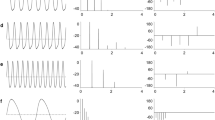Summary
-
1.
Populations of the sand-beach isopod,Excirolana chiltoni, show rhythmic swimming activity, under non-tidal conditions in the laboratory. The underlying period of this rhythm approximates the double-tidal interval of 24.8 hours rather than the tidal interval of 12.4 hours.
-
2.
Three patterns in swimming activity were observed: 1) diurnal activity, in which one peak of activity was observed each day; 2) semidiurnal equal activity, in which two peaks of equally intense activity were observed, and; 3) semidiurnal unequal activity in which a high level activity peak alternating with a low level activity peak was observed. The ability to perform each of these patterns resides in single individuals.
-
3.
The pattern of activity which was observed in any particular experiment reflected the wave form of the tide on the day preceding confinement of the population in the laboratory (Figs. 1 and 2).
-
4.
The application of turbulence cycles, in the laboratory, which simulate wave action on the beach can phase shift the ongoing rhythm of a population and can initiate rhythmic activity in previously arhythmic populations. One stimulus application per day initiates diurnal activity while two stimuli evoke semidiurnal activity. The effect of turbulent stimuli persists for several days after cessation of treatment indicating a long lasting conditioning effect of these stimuli on the pattern of endogenous activity (Figs. 6–10).
Similar content being viewed by others
References
Aschoff, J.: Exogenous and endogenous components in circadian rhythms. Cold Spr. Harb. Symp. quant. Biol.25, 11–28 (1960).
Aschoff, J.: Circadian activity pattern with two peaks. Ecology47, 657–662 (1966).
Barnwell, F. H.: Daily and tidal patterns of activity in individual fiddler crabs from the Woods Hole region. Biol. Bull.130, 1–17 (1966).
Barnwell, F. H.: The role of rhythmic system in the adaptation of fiddler crabs to the intertidal zone. Amer. Zool.8, 569–583 (1968).
Bennett, M. F., Shriner, J., Brown, R. A.: Persistent tidal cycles of spontaneous motor activity in the fiddler crab,Uca pugnax. Biol. Bull.112, 267–275 (1957).
Brown, F. A.: A unified theory for biological rhythms. In: Circadian clocks (ed. J. Aschoff). Amsterdam: North-Holland Publ. Comp. 1965.
Brown, F. A., Fingerman, M., Sandeen, M. I., Webb, H. M.: Persitent diurnal and tidal rhythms of color change in the Fiddler crabUca pugnax. J. exp. Zool.123, 29–60 (1953).
Brown, F. A., Hastings, J. W., Palmer, J. D.: The biological clock-two views. New York: Academic Press 1970.
Chandrashekaren, M. K.: Persistent tidal and diurnal rhythms of locomotot activity and oxygen consumption inEmerita asiatica (M.-EDW.). Z. vergl. Physiol.50, 137–150 (1965).
DeCoursey, P.: Phase control of activity in rodents. Cold Spr. Harb. Symp. quant. Biol.25, 49–56 (1960).
Enright, J. T.: Distribution, population dynamics and behavior of a sandbeach crustacean,Synchelidmm sp. Ph. D. Thesis University of California at Los Angeles 1961.
Enright, J. T.: The tidal rhythm of activity of a sand-beach amphibod. Z. vergl. Physiol.46, 276–313 (1963).
Enright, J. T.: Entrainment of a tidal rhythm. Science147, 864–867 (1965).
Enright, J. T.: Ecological aspects of endogenous rhythmicity. Ann. Rev. Ecol. Syst.l, 221–237 (1970).
Enright, J. T.: A virtuoso isopod: circa-lunar rhythms and their tidal fine structure. J. comp. Physiol.77, 141–162 (1972).
Fincham, A. A.: Rhythmic behavior of the intertidal amphibodBathyporeia pelagica. J. marine biol. Ass.50, 1057–1068 (1970).
Gauld, D. T., Buehanan, J. B.: The fauna of sandy beaches on the Gold Coast. Oikos7, 293–301 (1956).
Heusner, A. A., Enright, J. T.: Long-term activity recordings in small aquatic animals. Science154, 532–533 (1966).
Jones, D. A., Naylor, E.: The swimming rhythm of the sand beach isopodEurydice pulchra. J. exp. mar. Biol. Ecol.4, 189–199 (1970).
Klapow, L. A.: Ovoviviparity in the genusExcirolana (Crustacea: Isopoda). J. Zool.162, 359–369 (1970).
Klapow, L. A.: The ecology and behavior of a sand-beach isopod,Excirolana chiltoni: distribution, abundance, and temporal patterns in molting, reproduction and swimming activity. Ph. D. Thesis, University of California at San Diego (1971).
Morgan, E.: The activity rhythm of the amphipodCorophium volutator (Pallas) and its possible relationship to changes in hydrostatic pressure associated with the tides. J. Anim. Ecol.34, 731–746 (1965).
Palmer, J. D.: Daily and tidal components in the persistent rhythmic activity of the crabSesarma. Nature (Lond.)215, 64–66 (1967).
Pittendrigh, C. S.: Circadian rhythms and the circadian organization of living systems. Cold Spr. Harb. Symp. quant. Biol.25, 159–184 (1960).
Williams, B. G., Naylor, E.: Spontaneously induced rhythm of tidal periodicity in laboratory-rearedCarcinus. J. exp. Biol.47, 229–234 (1967).
Author information
Authors and Affiliations
Additional information
Many aspects of this paper are direct outgrowths of previous research conducted by Dr. James T. Enright. The generous assistance and advice which he offered at all stages of this research are greatly appreciated. I would also like to thank Charles K. Barry and Dr. Hans-Willi Honegger for the many stimulating hours of discussion which they volunteered. Dr. E. W. Fager and Dr. W. A. Newman offered many valuable criticisms in the preparation of this manuscript which I take pleasure in acknowledging. This research was supported by National Science Foundation Grant, GB5471.
Rights and permissions
About this article
Cite this article
Klapow, L.A. Natural and artificial rephasing of a tidal rhythm. J. Comp. Physiol. 79, 233–258 (1972). https://doi.org/10.1007/BF00694219
Received:
Issue Date:
DOI: https://doi.org/10.1007/BF00694219



